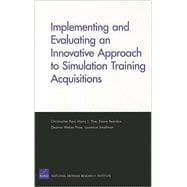
| Preface | iii | ||||
| Figures | ix | ||||
| Tables | xi | ||||
| Summary | xiii | ||||
| Acknowledgments | xxv | ||||
| Acronyms | xxvii | ||||
| CHAPTER ONE Introduction: The Legacy of JSIMS | 1 | (12) | |||
|
2 | (1) | |||
|
3 | (4) | |||
|
7 | (1) | |||
|
7 | (1) | |||
|
8 | (2) | |||
|
10 | (1) | |||
|
10 | (2) | |||
|
12 | (1) | |||
| CHAPTER TWO The Alt#4 Solution | 13 | (12) | |||
|
14 | (3) | |||
|
14 | (1) | |||
|
15 | (2) | |||
|
17 | (1) | |||
|
17 | (1) | |||
|
18 | (1) | |||
|
19 | (2) | |||
|
21 | (4) | |||
| CHAPTER THREE Other Approaches to Buying Simulation Training: Case Examples | 25 | (32) | |||
|
25 | (1) | |||
|
26 | (27) | |||
|
26 | (1) | |||
|
27 | (1) | |||
|
28 | (1) | |||
|
28 | (1) | |||
|
29 | (2) | |||
|
31 | (1) | |||
|
31 | (3) | |||
|
34 | (1) | |||
|
34 | (1) | |||
|
35 | (1) | |||
|
36 | (1) | |||
|
37 | (2) | |||
|
39 | (3) | |||
|
42 | (3) | |||
|
45 | (1) | |||
|
46 | (1) | |||
|
47 | (1) | |||
|
48 | (1) | |||
|
49 | (1) | |||
|
49 | (2) | |||
|
51 | (2) | |||
|
53 | (1) | |||
|
53 | (4) | |||
| CHAPTER FOUR The Economic Underpinnings of Alt#4: Relevant Theory and Literature | 57 | (18) | |||
|
57 | (5) | |||
|
62 | (4) | |||
|
66 | (3) | |||
|
69 | (2) | |||
|
71 | (1) | |||
|
72 | (3) | |||
| CHAPTER FIVE Challenges Facing the Prototype | 75 | (16) | |||
|
75 | (2) | |||
|
77 | (1) | |||
|
77 | (5) | |||
|
79 | (2) | |||
|
81 | (1) | |||
|
82 | (1) | |||
|
83 | (1) | |||
|
83 | (1) | |||
|
84 | (1) | |||
|
85 | (6) | |||
|
86 | (1) | |||
|
87 | (1) | |||
|
88 | (3) | |||
| CHAPTER SIX Critical Elements of a Prototype Implementation Plan | 91 | (18) | |||
|
92 | (4) | |||
|
96 | (9) | |||
|
96 | (2) | |||
|
98 | (1) | |||
|
98 | (1) | |||
|
99 | (1) | |||
|
100 | (2) | |||
|
102 | (1) | |||
|
102 | (1) | |||
|
103 | (1) | |||
|
104 | (1) | |||
|
104 | (1) | |||
|
105 | (1) | |||
|
106 | (3) | |||
| CHAPTER SEVEN How Will We Know If It Worked? Evaluating Alt#4 | 109 | (10) | |||
|
110 | (1) | |||
|
111 | (2) | |||
|
113 | (2) | |||
|
114 | (1) | |||
|
115 | (1) | |||
|
115 | (1) | |||
|
116 | (3) | |||
| CHAPTER EIGHT Conclusions: The Challenges of Expanding Use of Alt#4 Beyond the Prototype | 119 | (6) | |||
|
119 | (1) | |||
|
120 | (1) | |||
|
120 | (1) | |||
|
121 | (4) | |||
|
121 | (1) | |||
|
122 | (1) | |||
|
123 | (1) | |||
|
123 | (2) | |||
| Bibliography | 125 |
The New copy of this book will include any supplemental materials advertised. Please check the title of the book to determine if it should include any access cards, study guides, lab manuals, CDs, etc.
The Used, Rental and eBook copies of this book are not guaranteed to include any supplemental materials. Typically, only the book itself is included. This is true even if the title states it includes any access cards, study guides, lab manuals, CDs, etc.